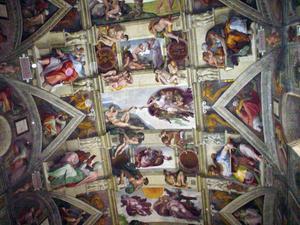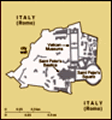Advertisement

 Creation of Adam
Creation of Adam
Sistine Chapel ceiling: I accidently took the picture of the frescoes on the ceiling. Oops.Vatican might be the smallest sovereign country in the world. Although we live in
Prati neighborhood located next to the City, and our apartment is within two minutes walking from San Pietro, we haven't stepped a foot inside the Vatican City prior today. Walking along via della Consolazione to our studio, we always wonder how it feels like to visit the Vatican as a normal tourist. As a "resident of Rome", I am obligated to visit the Holy Site, and I am glad that finally we had the opportunity to examine the city more throughly.
Tourists are always crowding around the main entrance to the Vatican, which happens to be the very entrance of St. Peter's Basilica. This is our main excuse of not going; as everybody's list in Rome is to visit Vatican, thus long line of people is a major turn-off.
As the common custom throughout Italy (and the world, I assume), everybody must have their shoulders and legs covered to enter a church. This is strictly enforced in San Pietro, and although it is a major temptation of wearing tank tops or shorts in hot Roman summer, that's a big no-no in entering the basilica. Many

 Swiss Guards
Swiss Guards
One of Michelangelo's less successful design: the Swiss Guard uniform.tourists are turned away after a few hours waiting in line, and of course there are many major arguments between ugly tourists versus Swiss Guards. Owell guess who win it ...
Stupid us, it happened at our first attemp to enter the holy site. Fortunately we live near by, so that within fifteen minutes, we changed our shorts into a jeans, and with a big grin to the Guards, we are finally walking under the very roof of the Vatican City.
The colorful Swiss Guards St. Peter's square, with 140+ statues on top of the double strays of colonade pillars and two huge fountains, feels like a stage in a bigger scale. The traditional Swiss Guard uniform, which consists of bright striped blue and gold, add the sense of staging actors. Michelangelo himself designed the costum of the guards back in 1500s.
From what I've read, it is a very selective process to be a Swiss guard. There are four major strict requirements to serve as one:
(1) you have to be a Swiss, living in one of the four Catholic cantons of Switzerland,
(2) you have to be a unmarried male between age of

 San Pietro
San Pietro
The big statue of St. Peter in front of the basilica dedicated for him in the Vatican City.nineteen and thirty,
(3) you are no less than 5'-6" ht. and trained by the elite Swiss Army, and
(4) if you are not a Swiss or fulfill any of the first three requirements, please see points
(1),
(2), and
(3).
Well, even though they look funny and cartoonist, they can speak and yell in many languages. They always stop tourists from entering prohibited areas and depends on where the people are from, as neutral Swiss, they were trained to speak at least four languages, some even speak Japanese. They always initiate the conversation in Italian, but as most stupid tourists are not from Italy, they will continue it in English. Then perhaps some French or German, and finally even Japanese. Don't you want to be a Swiss guard when you grow up.
Musei Vaticani The trick of visiting the always "most crowded museum in the world" Vatican Museums is by making an early
prenotazione or reservation by phone. We gathered few classmates to go to the Vatican Museums, and ordered tickets from the phone, with the help of our professor Pia. All we need to do is to show up on the day of the

 Gallery of Statues
Gallery of Statues
One out of 1,407 rooms of Musei Vaticani.reservation, and not from the major entrance of the Vatican City at the San Pietro, but by going around the Vatican City wall, and going through a smaller ticket booth as the major entrance for the Musei Vaticani. Not many people know about this secret doorway, which creates room to breath in. We entered the museum very easily, guarded by the museum personel, as many pairs of eyes from the queue line were bestowed upon us.
The museum was overwhelming, as one of the most art concentrated spot in the world, Musei Vaticani host hundred thousands of art, mainly the Italian Reneissance art, ranging from paintings, sculptures, frescoes, architectures, and maps. The collections are arranged in 1,407 rooms throughout the museum, and everything is as equally significant as the piece next to it. Major names like Boticelli, Michelangelo, Bramante, Bernini, and da Vinci, along with other thousand names are all over the place.
The major spot here is the Raphael's room, where he spent most of his life working for the Vatican. If I could pick a room to be my room, I would pick this room, complete with all the colorful frescoes he created and marble floors.

 Minus the pee-pee
Minus the pee-pee
Poor guy had his pee-pee chopped off by Pope Pius IX. The fig leaf plaster is attached to cover up his pain.But honestly, anywhere in the Vatican would be fine with me, as every inch of the area is significant for art. No wonder the Catholic throne is one of the richest state in the world, I wonder how much would they make if they decided to sell and auction all of these valuables.
In the middle of the museum was a piazza, with an ancient huge pine cone sculpture which is really intriguing. The sculpture was discovered in the
Pigna region in Rome, where our studio is located by the Pantheon. Nonetheless, it becomes one of my favorite sculptures in the world, a rarety in the nowadays culture. Who would sculpt a detailed pine cone, complete with all the nook and cranny, in this modern day?
A crime within the Vatican Museum wall: The Great Castration (Dan Brown's theory) Unfortunately, all of the male sculptures inside Vatican Museums were damaged. In 1857, Pope Pius IX thought that the "accurate representation of the male form" of the statues might threat the religious life of the Vatican. As the result, he grabbed a mallet and hacked off every genitalia of male sculptures inside the museum to prevent the

 The Last Judgement
The Last Judgement
Another accident of picture taking in the Sistine Chapel. Oops I did it again.spread of lust of the Vatican. The madness destroyed invaluable arts, and after he reigned from his power as a Pope, the successor tried to fix the damage by adding a patch in form of fig leaves at every crotch of statues. Of course the main question still remains: where the heck are the stone penises? Are they hidden somewhere in a secret room inside the Vatican wall?
Sistine Chapel: the unforgetable moment Sistine Chapel. If a visit to the Vatican Museums is a must, then visiting the Sistine Chapel inside the museum is a must-est. Completed in the early 1500's, Michelangelo had started out with having some apprentices working under his supervision, but not long after that, he fired them all and worked for full four years to complete the ceiling frescoes. It is perhaps to be considered as the most advance achievement in western art history, the Creation of Adam is so powerful as it becomes the symbol found in all over the world. The bright colors of the frescoes are even puzzling the modern day renovation team in the 1990s, after hundred of years covered in dust, candle smokes and incence residue, and to

 I saw the sign
I saw the sign
Do we need to follow the sign?see once again the vivid color of the frescoes that had made pope and public speechless in the chapel's opening day in 1512.
There was a huge line to enter the chapel, and we were waiting in queue and walking through tons of hallways, rooms, and arts, just to wait until the people inside the chapel get out and finally see it ourselves. Tension was running high, and throughout the waiting time, there were many annuncements through speakers to remind the visitors, in five different languages, that visitors to keep it quiet as entering the chapel as respecting a praying place, and NOT to take any pictures inside the room in any circumstances. We as a group of law abiding citizens, putting down our cameras and preparing to enter the chapel as if we're attending a mass. But what waiting inside was more than I have had in mind.
Inside the chapel, chaos was everywhere. Flashing photographs were highlighting the frescoes, people were cramming every inch of the chapel floor, as some tried to walk through the crowd, people were talking and even screaming to each other. And out of nowhere, just like God's voice, a voice came

 Pietà
Pietà
The famous Pietà by Michelangelo, behind a thick glass.out of speakers inside the chapel engulfed all the noise, in five different languages, "
YOU ARE REMINDED TO BE QUIET!!! THIS IS GOD'S HOUSE AND NO PHOTOGRAPHY ALLOWED INSIDE THE CHAPEL!!!". It was hillarious and chaotic, but by accident, I pressed my camera's button aiming at the Creation of Adam frescoes on the ceiling, the Last Judgement frescoes in main altar and many others. He-he-he.
The end of the Museums and Vatican flag role during WWII Although the museum has been opened for more than 500 years, the expansion of the structures wasn't stop at its track. There are many modern European looking additional structures, which consists of metal and glass. The double spiral ramps toward the bottom of the museum supposedly designed for papal escape with horse, and wide enough to accomodate papal carts, aka pope-mobile. Above the mega structure, there is glass covered atrium and metal/glass modern design incorporated into the older stone and marble structure.
As the ramp is open for public to walk through, it was definetaly not designed accordingly to the American Disablity Acts, as we know it today. It is too steep, and along the ramp, there are many triangular

 Mass at St. Peter's
Mass at St. Peter's
A Sunday mass at the San Pietro tarbenacle.yellow signs to warn the visitors about the slippery condition when wet. We had a good time acting as if we were slip and fell. It was a good time.
Yellow and white Vatican flag with the papal symbol has a special meaning for all the Catholics and Christians in general, especially during the Second World War. As Italy was part of the war, with many respects, the Allied forces pilots flew above Rome, dropping some bombs along the way at strategic places, with their best avoiding the Vatican properties. All the churches in Rome belongs to the Vatican as the papal properties, along with some other structures inside the wall and the surrounding area. The only way for pilots to identify papal structures was by having huge Vatican flags drapped over the roof of the structures, as a signal of not dropping bombs there. Many of the palazzo and historical structures were damaged by the war, but all the Vatican properties were intact. Some of the citizen of Rome who happened to own the Vatican flag was drapping over the flag on their roof as well, and they were saved by disguised. Just fun fact of a Vatican

 Baldacchino
Baldacchino
The famous baldacchino of San Pietro.history.
Sunday Mass at the Holy Altar We attended the holy mass at the St. Peter's main altar on the next day. Even though it wasn't led by the pope, the mass has a special meaning for me, as we were siting face to face with the Bernini's main altar design. Although it was in Italian, the crowd seemed to be diverse and not only Italians.
After the mass, we decided to take a good look around the basilica itself. There are two things that I've always wanted to see inside the basilica: the Pietà by Michelangelo and the Baldacchino by Bernini.
Inside the Basilica: La Pietà La Pietà (c.1499) is now protected behind a thick glass wall, in where it has been sitting on one of the side chapel. In 1972, a crazy Australian attacked the sculpture with a sledge hammer, damaging it in some area. As the whole world weeped, the Vatican decided to take precaution for the next attact to the art by having protected glass around it. So I did not have a chance to examine it closely to see whether the reading I was doing is correct.

 Climbing up the dome
Climbing up the dome
The hallway to climb up the dome.Supposedly, the figures are quite out of proportion: a fully-grown man cradled full-length in a woman's lap. If Christ were to be human scale, the Virgin, standing, would be almost three times taller than Christ. This could very well be intentional, however: as the statue was moved from its original location in France, and nobody knows in which position it was before. If it was to be situated in a high place, Michelangelo could have intentionally deformed it, to balance human sight aberration. However, much of the Virgin's size is concealed in her drapery, and the figures look quite natural.
The other things we saw during our after mass visit were the Baldacchino by Bernini, and the popes burial chamber under the basilica.
The cupula visit: the top of the Basilica Several days later, Jason and I dragged Ryan along to climb up the dome of St. Peter's. Apparently many American tourists have some issues climbing up to the top, as there is no elevator or any help in any way to get up. After passing the checking points for tickets, dress code, etc, we started to hike to the top. Hiking is the right term

 The altar view from the dome
The altar view from the dome
The main altar view from above.to describe it; as hundreds of stairs were designed in different way to make its way to the top. At some points, the stairs are so narrow that no more than two thin people could fit side by side, meaning no passing by other slower tourists.
The first level of the hiking is the roof of the Basilica, where the main apostles and Jesus statues are located. I was quite surprise to find out that they are much taller than I had though before: each is about thirteen feet tall. Inside the first level, a viewing area is formed around the dome, looking down at the Basilica's interior, up high above the main altar and the Baldacchino. But the journey was not over yet, and we continued on our quest to the top. Up above, the dome was still intimidating, as if telling us to quickly get to the top.
When the ceiling started to tilt to our right, we knew right away that we follow the form of the dome. Then a scary thought started to form, as I realized that nothing I could do if all the sudden, the wall crumbles and we would fall directly

 St. Peter
St. Peter
San Pietro's axis of via della Consiliazione.to the Basilica down below. Maybe I started to develop a claustrophobia?
Finally we reached the top. WOW. The platform is not big at all, we barely fit in one area at a time, not so much room to walk around the dome. We managed to observe the colonnade of St. Peter's square and the via della Consoliazione down below, and the Vatican wall surrounding papal palace, the "government" palace of the Vatican, and many smaller buildings and garden we didn't even know about. And beyond, many sites in Rome are revealed: the Castel San'Angelo and the Porta, Monument Vittorio, Villa Medici, and even the water tower at the Testaccio.
And of course Ryan was so grateful that we dragged him along to go to the top. If he didn't go, this would be one thing he definetely would regret later on, as our time in Rome (and Italy) is ticking away.
Advertisement
Tot: 0.42s; Tpl: 0.03s; cc: 27; qc: 133; dbt: 0.177s; 1; m:domysql w:travelblog (10.17.0.13); sld: 1;
; mem: 1.5mb








































researcher
non-member comment
the great castration
Did the Great Castration actually happen? because the only proof i have is this site and the famous book by Dan Brown, and he made a lot of mistakes thank you for your time